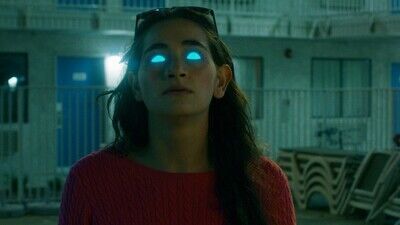Shot in greater Chicago, the movie throws you into the middle of its premise, and establishes right away that this is a science fiction movie that’s going to explore its ideas from the points-of-view of aliens rather than the humans who encounter them. The main characters are two lovers from a dying world who’ve come here separately to reunite and make a fresh start and end up together after some complications, living an outwardly typical suburban American lifestyle. The aliens are played by various actors, in the manner of a science fiction or horror film where creatures or spirits pass from one host to another. The main cast includes Isabel Alamin, Molly Plunk, Victoria Misu, and Mike Lopez, and the tale is occasionally narrated by Russell Mael in a not-quite-monotone that’s sneakily funny at times.
Everybody is on-point in terms of a unified mode of performance. The visitors are deadpan, quietly internal when dealing with humans yet super-alert, and a bit too cheerful-chirpy or overly invested in what they’ve learned about human life and how they’re chosen to represent or regurgitate our behavior. There’s a strangely touching shot of a “male” and “female” extraterrestrial couple lying on a couch together watching TV, and the woman stretches her long leg out and touches the man with her foot; it’s an unknowing parody of the way people who are physically intimate with each other express that with casual touch. Humans who interact with aliens in human skins know there’s something “off” but can’t figure out what it is. There’s also a shot of a character eating snack food out of a can with a spoon, and it might make you think about what it means to eat something out of a can with a spoon.
Disguises are necessary. The initial form of an inhabited human body has glowing fuchsia eyes. Special contacts are needed to cover this up. The anatomies of the creatures beneath human skins are glimpsed but not shown in totality. These visitors are giving very good performances as us, and anything that’s “not right” could be chalked up to them being humans who are a bit odd. Since everybody’s a bit odd once you get to know them, they can get away with a lot.
They’ve ended up in suburbia for whatever reason, and not the “American Beauty” or “The Graduate” kind of suburbia where yuppies in expensive clothes drive fancy cars while thinking about the empty materialism of their lives. This is a more, er, earthbound kind of suburbia. Car culture rules supreme. People shop at convenience stores and discount clothing stores. Something about the way Clark and cinematographer Darryl Pittman shoot their real-life locations, including a standard-issue “motor lodge” motel and a cookie-cutter suburban house, evokes a secondary point of interest in Alfred Hitchcock’s “Psycho”: the way the film captures what the United States looked like in the middle of the 20th century, when the interstate highway system was being built, a lot of smaller towns were being bypassed and forgotten and choked off from prosperity, and the “freedom” of the open road transmogrified into fearfulness and despair if you were running away from something instead of towards something.

